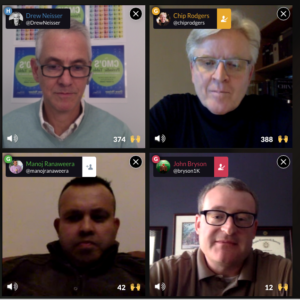 Social customer service is becoming more important to a company’s success than ever before. What was once primarily used as an opportunity for good PR and marketing strategies is now an integral piece of the customer service puzzle. When a company publicly engages with their customers via social it shows their followers they are not afraid to openly discuss any issue that may come up and take responsibility for their mistakes. This sort of public interaction creates a deeper sense of trust between a business and their customer. But how do you define where in your company social customer service belongs? Where do you draw the line when it comes to addressing complaints? How do you know if your efforts with social are even making a difference?
Social customer service is becoming more important to a company’s success than ever before. What was once primarily used as an opportunity for good PR and marketing strategies is now an integral piece of the customer service puzzle. When a company publicly engages with their customers via social it shows their followers they are not afraid to openly discuss any issue that may come up and take responsibility for their mistakes. This sort of public interaction creates a deeper sense of trust between a business and their customer. But how do you define where in your company social customer service belongs? Where do you draw the line when it comes to addressing complaints? How do you know if your efforts with social are even making a difference?
Giovanni Tavani has the answers to these questions and then some. At Dell for over 14 years, Giovani currently serves as Global Social Media Manager. In 2010 Giovanni was appointed as leader of the Social Media Support team which is currently up and running in 15 different languages. At present Giovanni leads the Global operations for EMEA, Latin America and APJ and drives the development of customer solutions and digital content through Social Media. I will be talking social customer service with Giovani today at the Customer Service Summit in New York but you can read some of our conversation here:
Drew: Dell was an early adopter of social customer service— how has your approach evolved over the last couple of years? Then,
Yes, we expanded our team & scope to all global languages, became a central team/organization and developed our approach, no longer “limited” to handling customers` queries but also to build meaningful content for our customers to anticipate their needs.
Drew: Social listening is a big challenge for popular brands — brands like McDonalds get several mentions a minute and of course not all are positive. How do you decide which complaints to respond to? Does every complaint warrant are response?
We do not only receive complaints. In the early days people used social media to complain, now even users consider it as a channel like voice or chat. We respond to all posts except, mostly on forums, where tech savvy users interact with each other with good solutions/suggestions.
Drew: There is some debate in the industry about celebrity complaints. Some argue these folks warrant special treatment as they have such a large sphere of influence, Others will say that no customer should be more important than another in this arena. What do you think?
I agree all customers should be treated in the same way, which means….if we know that an exceptional CX can be delivered to celebrities, I don`t see why the same exceptional experience shouldn`t be delivered to all customers!
Drew: Have their been cases with when social listening identified a product issue or opportunity and if so, how does your team aggregate customer feedback and determine what should be escalated to the product development teams?
With regards to Win10 upgrade, which went very well, we knew it would be a top social topic, so we built huge campaigns of tips & tricks, how-tos, videos to anticipate all potential questions and to make the Win10 experience even better for our customers. We decided to anticipate rather than suffering from too many queries on the same topic if we didn`t act proactively.
Drew: Can you speak about a particular social customer service success story?
Every time we give an answer to a customer and we also take the action in an end2end fashion, that`s our success stories every day. We never ask another department to handle and we never ask customers to contact someone else or to change the channel. That`s the successful approach we have and want to keep investing on. In terms of strategy, I am proud of having been the one to have some game changing ideas in the past couple of years: do not limit to customer support but build posts with #DellTips (AKA proactive solutions) in an attractive way, i.e. bring in people with digital marketing skills into customer support rather than “limit” to IT technical profiles. On the video strategy piece, we considered 1. YouTube is the 2nd largest search engine of the web and 2. Videos built through agencies are expensive. So I had the idea to see what universities could do in some kind of R&D environment focused on audio-visual medias. We found the best place in Brazil, in a very well known university campus, where movies and animations are created. We signed a deal with them to exchange skills and internships and build professional videos with animations and talking heads in all the languages we needed while keeping costs under control.
Drew: Does your purview include international social accounts? If so, what are some of the challenges that you’ve been able to overcome?
Yes, we cover 18 languages (and many more countries). The biggest challenge I am still dealing with is the huge growth of China on social media. 1 year ago we could handle the volumes with 6 community managers, now we are at 22 and need 20 more. I could imagine China would grow (that was pretty obvious from day 1….) but the growth is more of an explosion now as it`s going so fast. So the challenge is mainly on keeping leadership aware of a fact Vs talking about a forecast and then go hire the best profile and fast. This is still work in progress…..and I guess that is just the beginning of China growth on Social Media, also considering their WeChat platform is really cool and it already works outside of China.
Drew: is there a company out there that you think does a really amazing job with social customer service? If so, why?
I see Emirates airline as a good example. I travel a lot and use them a lot. Their idea of CX is just “excellence” in every part of their customer journey and they always respond in a timely manner with a real solution with professional and empowered agents. There are many other companies like Coca-Cola, Nike, Adidas which are really great on social media but I prefer to look at companies which sell a product that generates a long lasting customer journey Vs a short term product consumption. These other companies can afford having mainly marketing to handle their social presence, while companies like Dell, airlines o car makers must have a social social customer support presence, because the product usage experience is as important as the purchase and unboxing experience.
Drew: How do evaluate the success of your social customer service program?
Growing volumes year-on-year, similar KPI/metrics as the rest of the company, CX above all, to have the right level of trust and visibility from the leadership team.


